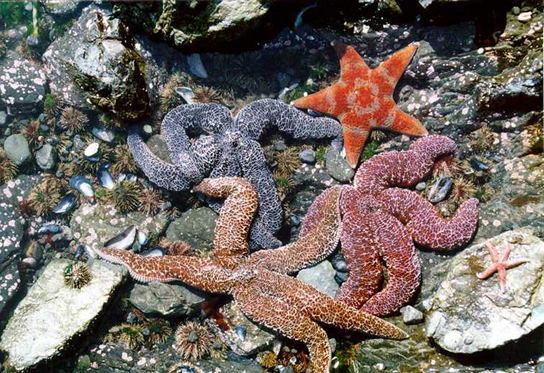| << Chapter < Page | Chapter >> Page > |
The physical diversity of the ocean has a significant influence on the diversity of organisms that live within it. The ocean is categorized into different zones based on how far light reaches into the water. Each zone has a distinct group of species adapted to the biotic and abiotic conditions particular to that zone.
The intertidal zone ( [link] ) is the oceanic region that is closest to land. With each tidal cycle, the intertidal zone alternates between being inundated with water and left high and dry. Generally, most people think of this portion of the ocean as a sandy beach. In some cases, the intertidal zone is indeed a sandy beach, but it can also be rocky, muddy, or dense with tangled roots in mangrove forests. The intertidal zone is an extremely variable environment because of tides. Organisms may be exposed to air at low tide and are underwater during high tide. Therefore, living things that thrive in the intertidal zone are often adapted to being dry for long periods of time. The shore of the intertidal zone is also repeatedly struck by waves and the organisms found there are adapted to withstand damage from the pounding action of the waves ( [link] ). The exoskeletons of shoreline crustaceans (such as the shore crab, Carcinus maenas ) are tough and protect them from desiccation (drying out) and wave damage. Another consequence of the pounding waves is that few algae and plants establish themselves in constantly moving sand or mud.

The neritic zone ( [link] ) extends from the margin of the intertidal zone to depths of about 200 m (or 650 ft) at the edge of the continental shelf. When the water is relatively clear, photosynthesis can occur in the neritic zone. The water contains silt and is well-oxygenated, low in pressure, and stable in temperature. These factors all contribute to the neritic zone having the highest productivity and biodiversity of the ocean. Phytoplankton, including photosynthetic bacteria and larger species of algae, are responsible for the bulk of this primary productivity. Zooplankton, protists, small fishes, and shrimp feed on the producers and are the primary food source for most of the world’s fisheries. The majority of these fisheries exist within the neritic zone.
Beyond the neritic zone is the open ocean area known as the oceanic zone ( [link] ). Within the oceanic zone there is thermal stratification. Abundant phytoplankton and zooplankton support populations of fish and whales. Nutrients are scarce and this is a relatively less productive part of the marine biome. When photosynthetic organisms and the organisms that feed on them die, their bodies fall to the bottom of the ocean where they remain; the open ocean lacks a process for bringing the organic nutrients back up to the surface.
Beneath the pelagic zone is the benthic realm, the deepwater region beyond the continental shelf ( [link] ). The bottom of the benthic realm is comprised of sand, silt, and dead organisms. Temperature decreases as water depth increases. This is a nutrient-rich portion of the ocean because of the dead organisms that fall from the upper layers of the ocean. Because of this high level of nutrients, a diversity of fungi, sponges, sea anemones, marine worms, sea stars, fishes, and bacteria exists.

Notification Switch
Would you like to follow the 'Nsc 1406: contemporary biology' conversation and receive update notifications?